Soil Moisture Retrieval Using Multistatic L-Band SAR and Effective Roughness Modeling
Abstract
:1. Introduction
2. Materials and Methods
2.1. Study Site
2.2. Airborne SAR Data
2.3. Ground Measurements
2.4. Effective Roughness Modeling as a Tool for Soil Moisture Retrieval
2.5. Experimental Set-Up
3. Results and Discussion
3.1. Backscatter Simulations and Soil Moisture Retrieval Using In Situ Measured Surface Roughness Parameters
3.2. Modeling Effective Root-Mean-Square Height s from SAR Backscatter
3.3. Modeling Effective Correlation Length l from SAR Backscatter and Bistatic Scattering
3.4. Soil Moisture Retrieval Based on Effective Roughness Modeling
3.5. Evaluating Different Soil Moisture Retrieval Approaches
4. Conclusions
Author Contributions
Funding
Institutional Review Board Statement
Informed Consent Statement
Data Availability Statement
Acknowledgments
Conflicts of Interest
References
- Kornelsen, K.C.; Coulibaly, P. Advances in soil moisture retrieval from synthetic aperture radar and hydrological applications. J. Hydrol. 2013, 476, 460–489. [Google Scholar] [CrossRef]
- Meyer, F. Spaceborne Synthetic Aperture Radar: Principles, data access, and basic processing techniques. In Synthetic Aperture Radar (SAR) Handbook: Comprehensive Methodologies for Forest Monitoring and Biomass Estimation; SERVIR Global Science Coordination Office: Huntsville, AL, USA, 2019; pp. 21–64. [Google Scholar]
- Schmugge, T. Remote sensing of surface soil moisture. J. Appl. Meteorol. 1978, 17, 1549–1557. [Google Scholar]
- Ulaby, F.; Moore, R.; Fung, A. Rader remote sensing and surface scattering and emission theory. In Microwave Remote Sensing Active and Passive; Artech House Publishers: Norwood, MA, USA, 1982; Volume 2. [Google Scholar]
- Ulaby, F.; Moore, R.; Fung, A. From theory to applications. In Microwave Remote Sensing Active and Passive; Artech House Publishers: Norwood, MA, USA, 1986; Volume 3. [Google Scholar]
- Karthikeyan, L.; Pan, M.; Wanders, N.; Kumar, D.N.; Wood, E.F. Four decades of microwave satellite soil moisture observations: Part 1. A review of retrieval algorithms. Adv. Water Resour. 2017, 109, 106–120. [Google Scholar] [CrossRef]
- Choker, M.; Baghdadi, N.; Zribi, M.; El Hajj, M.; Paloscia, S.; Verhoest, N.E.; Lievens, H.; Mattia, F. Evaluation of the Oh, Dubois and IEM backscatter models using a large dataset of SAR data and experimental soil measurements. Water 2017, 9, 38. [Google Scholar] [CrossRef]
- Fung, A.K.; Li, Z.; Chen, K.S. Backscattering from a randomly rough dielectric surface. IEEE Trans. Geosci. Remote Sens. 1992, 30, 356–369. [Google Scholar] [CrossRef]
- Ferrazzoli, P.; Guerriero, L.; Del Monaco, C.I.; Solimini, D. A further insight into the potential of bistatic SAR in monitoring the earth surface. In Proceedings of the IGARSS 2003, 2003 IEEE International Geoscience and Remote Sensing Symposium. Proceedings (IEEE Cat. No. 03CH37477), Toulouse, France, 21–25 July 2003; Volume 2, pp. 776–777. [Google Scholar]
- Pierdicca, N.; Pulvirenti, L.; Ticconi, F.; Brogioni, M. Radar bistatic configurations for soil moisture retrieval: A simulation study. IEEE Trans. Geosci. Remote Sens. 2008, 46, 3252–3264. [Google Scholar] [CrossRef]
- Pierdicca, N.; De Titta, L.; Pulvirenti, L.; Della Pietra, G. Bistatic radar configuration for soil moisture retrieval: Analysis of the spatial coverage. Sensors 2009, 9, 7250–7265. [Google Scholar] [CrossRef]
- Brogioni, M.; Pettinato, S.; Macelloni, G.; Paloscia, S.; Pampaloni, P.; Pierdicca, N.; Ticconi, F. Sensitivity of bistatic scattering to soil moisture and surface roughness of bare soils. Int. J. Remote Sens. 2010, 31, 4227–4255. [Google Scholar]
- Johnson, J.T.; Ouellette, J.D. Polarization features in bistatic scattering from rough surfaces. IEEE Trans. Geosci. Remote Sens. 2013, 52, 1616–1626. [Google Scholar] [CrossRef]
- Zeng, J.; Chen, K.S. Theoretical study of global sensitivity analysis of L-band radar bistatic scattering for soil moisture retrieval. IEEE Geosci. Remote Sens. Lett. 2018, 15, 1710–1714. [Google Scholar] [CrossRef]
- Pierdicca, N.; Brogioni, M.; Fascetti, F.; Ouellette, J.D.; Guerriero, L. Retrieval of biogeophysical parameters from bistatic observations of land at L-band: A theoretical study. IEEE Trans. Geosci. Remote Sens. 2021, 60, 1–17. [Google Scholar] [CrossRef]
- Willis, N.J. Bistatic Radar; SciTech Publishing: Raleigh, NC, USA, 2005; Volume 2. [Google Scholar]
- Rodriguez-Alvarez, N.; Bosch-Lluis, X.; Camps, A.; Vall-Llossera, M.; Valencia, E.; Marchan-Hernandez, J.F.; Ramos-Perez, I. Soil moisture retrieval using GNSS-R techniques: Experimental results over a bare soil field. IEEE Trans. Geosci. Remote Sens. 2009, 47, 3616–3624. [Google Scholar] [CrossRef]
- Egido, A.; Caparrini, M.; Ruffini, G.; Paloscia, S.; Santi, E.; Guerriero, L.; Pierdicca, N.; Floury, N. Global navigation satellite systems reflectometry as a remote sensing tool for agriculture. Remote Sens. 2012, 4, 2356–2372. [Google Scholar] [CrossRef] [Green Version]
- Zribi, M.; Motte, E.; Baghdadi, N.; Baup, F.; Dayau, S.; Fanise, P.; Guyon, D.; Huc, M.; Wigneron, J.P. Potential Applications of GNSS-R observations over agricultural areas: Results from the GLORI airborne campaign. Remote Sens. 2018, 10, 1245. [Google Scholar] [CrossRef] [Green Version]
- Zeng, J.; Chen, K.S.; Bi, H.; Chen, Q.; Yang, X. Radar response of off-specular bistatic scattering to soil moisture and surface roughness at L-band. IEEE Geosci. Remote Sens. Lett. 2016, 13, 1945–1949. [Google Scholar] [CrossRef]
- Chen, K.S.; Wu, T.D.; Tsang, L.; Li, Q.; Shi, J.; Fung, A.K. Emission of rough surfaces calculated by the integral equation method with comparison to three-dimensional moment method simulations. IEEE Trans. Geosci. Remote Sens. 2003, 41, 90–101. [Google Scholar]
- Wu, T.D.; Chen, K.S. A reappraisal of the validity of the IEM model for backscattering from rough surfaces. IEEE Trans. Geosci. Remote Sens. 2004, 42, 743–753. [Google Scholar]
- Ulaby, F.T.; Kouyate, F.; Fung, A.K.; Sieber, A.J. A backscatter model for a randomly perturbed periodic surface. IEEE Trans. Geosci. Remote Sens. 1982, GE-20, 518–528. [Google Scholar] [CrossRef]
- Davidson, M.W.; Le Toan, T.; Mattia, F.; Satalino, G.; Manninen, T.; Borgeaud, M. On the characterization of agricultural soil roughness for radar remote sensing studies. IEEE Trans. Geosci. Remote Sens. 2000, 38, 630–640. [Google Scholar] [CrossRef] [Green Version]
- Callens, M.; Verhoest, N.E.; Davidson, M.W. Parameterization of tillage-induced single-scale soil roughness from 4-m profiles. IEEE Trans. Geosci. Remote Sens. 2006, 44, 878–888. [Google Scholar] [CrossRef]
- Verhoest, N.E.; Lievens, H.; Wagner, W.; Álvarez-Mozos, J.; Moran, M.S.; Mattia, F. On the soil roughness parameterization problem in soil moisture retrieval of bare surfaces from synthetic aperture radar. Sensors 2008, 8, 4213–4248. [Google Scholar] [CrossRef] [PubMed] [Green Version]
- Lievens, H.; Vernieuwe, H.; Alvarez-Mozos, J.; De Baets, B.; Verhoest, N.E. Error in radar-derived soil moisture due to roughness parameterization: An analysis based on synthetical surface profiles. Sensors 2009, 9, 1067–1093. [Google Scholar] [CrossRef] [Green Version]
- Lievens, H.; Verhoest, N.E.; Keyser, E.D.; Vernieuwe, H.; Matgen, P.; Álvarez-Mozos, J.; De Baets, B. Effective roughness modelling as a tool for soil moisture retrieval from C-and L-band SAR. Hydrol. Earth Syst. Sci. 2011, 15, 151–162. [Google Scholar] [CrossRef] [Green Version]
- Su, Z.; Troch, P.; De Troch, F. Remote sensing of soil moisture using EMAC/ESAR data. In Proceedings of the IGARSS’96, 1996 International Geoscience and Remote Sensing Symposium, Lincoln, NE, USA, 31 May 1996; Volume 2, pp. 1303–1305. [Google Scholar]
- Meta, A.; Trampuz, C.; Coccia, A.; Ortolani, M.; Turtolo, R. First results of the BelSAR L band airborne bistatic fully polarimetric Synthetic aperture radar campaign. In Proceedings of the 2017 IEEE International Geoscience and Remote Sensing Symposium (IGARSS), Fort Worth, TX, USA, 23–28 July 2017; pp. 1040–1042. [Google Scholar]
- de Macedo, K.A.C.; Placidi, S.; Meta, A. Bistatic and monostatic insar results with the metasensing airborne sar system. In Proceedings of the 2019 6th Asia-Pacific Conference on Synthetic Aperture Radar (APSAR), Xiamen, China, 26–29 November 2019; pp. 1–5. [Google Scholar]
- Fore, A.G.; Chapman, B.D.; Hawkins, B.P.; Hensley, S.; Jones, C.E.; Michel, T.R.; Muellerschoen, R.J. UAVSAR polarimetric calibration. IEEE Trans. Geosci. Remote Sens. 2015, 53, 3481–3491. [Google Scholar] [CrossRef]
- Baghdadi, N.; Dubois-Fernandez, P.; Dupuis, X.; Zribi, M. Sensitivity of main polarimetric parameters of multifrequency polarimetric SAR data to soil moisture and surface roughness over bare agricultural soils. IEEE Geosci. Remote Sens. Lett. 2012, 10, 731–735. [Google Scholar] [CrossRef] [Green Version]
- Abdel-Messeh, M.; Quegan, S. Variability in ERS scatterometer measurements over land. IEEE Trans. Geosci. Remote Sens. 2000, 38, 1767–1776. [Google Scholar] [CrossRef]
- Mladenova, I.E.; Jackson, T.J.; Bindlish, R.; Hensley, S. Incidence angle normalization of radar backscatter data. IEEE Trans. Geosci. Remote Sens. 2012, 51, 1791–1804. [Google Scholar] [CrossRef]
- Oh, Y.; Sarabandi, K.; Ulaby, F.T. An empirical model and an inversion technique for radar scattering from bare soil surfaces. IEEE Trans. Geosci. Remote Sens. 1992, 30, 370–381. [Google Scholar] [CrossRef]
- Dobson, M.C.; Ulaby, F.T.; Hallikainen, M.T.; El-Rayes, M.A. Microwave dielectric behavior of wet soil-Part II: Dielectric mixing models. IEEE Trans. Geosci. Remote Sens. 1985, GE-23, 35–46. [Google Scholar] [CrossRef]
- Gupta, H.V.; Kling, H.; Yilmaz, K.K.; Martinez, G.F. Decomposition of the mean squared error and NSE performance criteria: Implications for improving hydrological modelling. J. Hydrol. 2009, 377, 80–91. [Google Scholar] [CrossRef] [Green Version]
- Hastie, T.; Tibshirani, R.; Friedman, J.H.; Friedman, J.H. The Elements of Statistical Learning: Data Mining, Inference, and Prediction; Springer: New York, NY, USA, 2009; Volume 2. [Google Scholar]
- Wu, T.D.; Chen, K.S.; Shi, J.; Lee, H.W.; Fung, A.K. A study of an AIEM model for bistatic scattering from randomly rough surfaces. IEEE Trans. Geosci. Remote Sens. 2008, 46, 2584–2598. [Google Scholar]
- Zeng, J.; Chen, K.S.; Bi, H.; Zhao, T.; Yang, X. A comprehensive analysis of rough soil surface scattering and emission predicted by AIEM with comparison to numerical simulations and experimental measurements. IEEE Trans. Geosci. Remote Sens. 2016, 55, 1696–1708. [Google Scholar] [CrossRef]
- Voronovich, A.G.; Zavorotny, V.U. Full-polarization modeling of monostatic and bistatic radar scattering from a rough sea surface. IEEE Trans. Antennas Propag. 2013, 62, 1362–1371. [Google Scholar] [CrossRef]
- Álvarez-Mozos, J.; Casalí, J.; González-Audícana, M.; Verhoest, N.E. Assessment of the operational applicability of RADARSAT-1 data for surface soil moisture estimation. IEEE Trans. Geosci. Remote Sens. 2006, 44, 913–924. [Google Scholar] [CrossRef]
- Bouchat, J.; Tronquo, E.; Lievens, H.; Verhoest, N.; Defourny, P. Assessing the potential of fully-polarimetric simultaneous mono-and bistatic airborne SAR acquisitions in L-band for applications in agriculture and hydrology. In Proceedings of the 2021 IEEE International Geoscience and Remote Sensing Symposium IGARSS, Brussels, Belgium, 11–16 July 2021; pp. 2703–2706. [Google Scholar]
- Lievens, H.; Verhoest, N.E. On the retrieval of soil moisture in wheat fields from L-band SAR based on water cloud modeling, the IEM, and effective roughness parameters. IEEE Geosci. Remote Sens. Lett. 2011, 8, 740–744. [Google Scholar] [CrossRef]
- Yang, Y.; Chen, K.S.; Xu, P.; Liu, Y. An update of AIEM model with multiple scattering of rough surface. In Proceedings of the 2017 IEEE International Geoscience and Remote Sensing Symposium (IGARSS), Fort Worth, TX, USA, 23–28 July 2017; pp. 4459–4462. [Google Scholar]
- Giraldez, A.E. Saocom-1 Argentina L band SAR mission overview. In Proceedings of the Coastal and Marine Applications of SAR Symp, Svalbard, Norway, 8–12 September 2003. [Google Scholar]
- Kellogg, K.; Hoffman, P.; Standley, S.; Shaffer, S.; Rosen, P.; Edelstein, W.; Dunn, C.; Baker, C.; Barela, P.; Shen, Y.; et al. NASA-ISRO synthetic aperture radar (NISAR) mission. In Proceedings of the 2020 IEEE Aerospace Conference, Big Sky, MT, USA, 7–14 March 2020; pp. 1–21. [Google Scholar]
- Davidson, M.W.; Furnell, R. ROSE-L: Copernicus L-Band Sar Mission. In Proceedings of the 2021 IEEE International Geoscience and Remote Sensing Symposium IGARSS, Online, 29 March–1 April 2021; pp. 872–873. [Google Scholar]
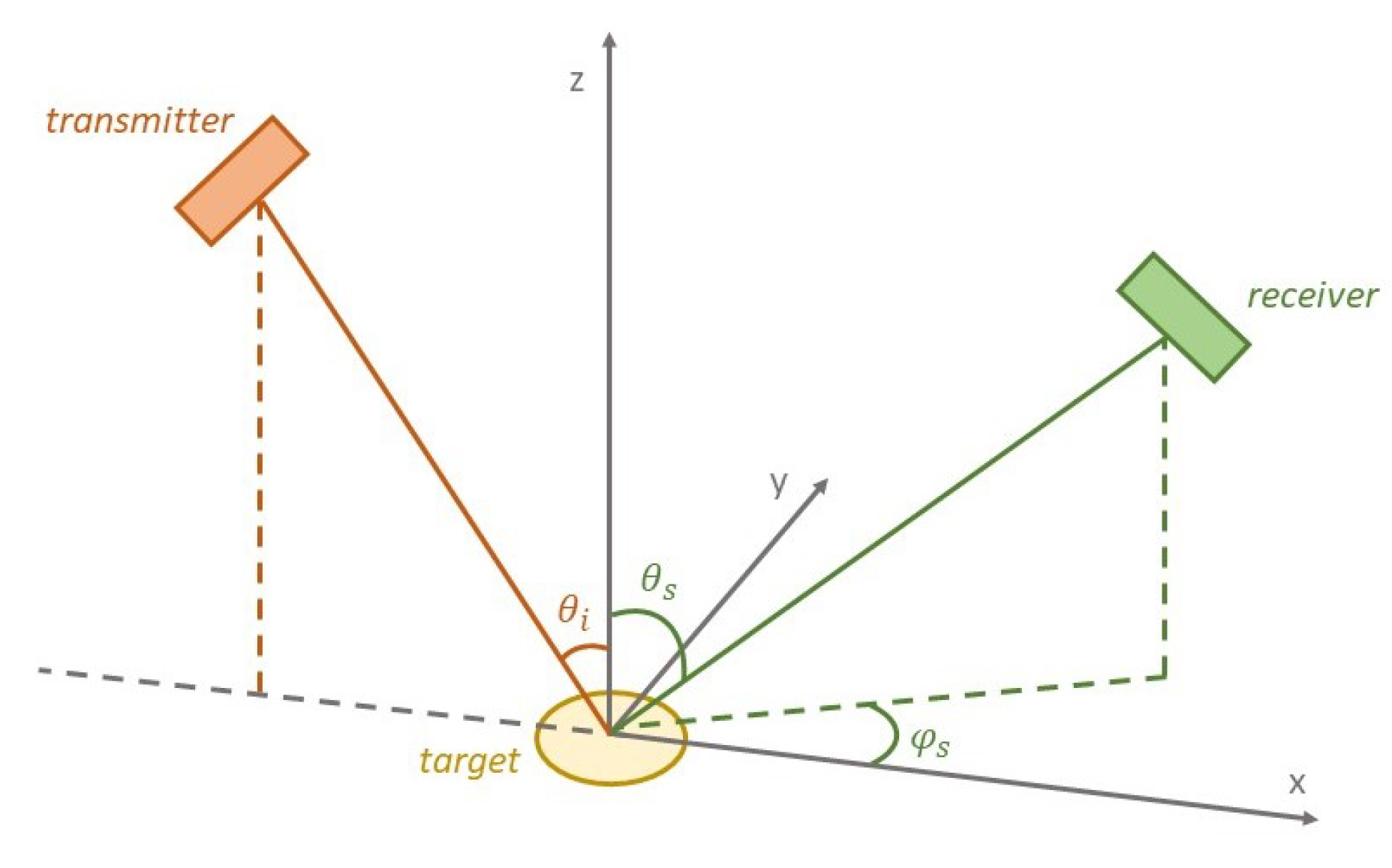

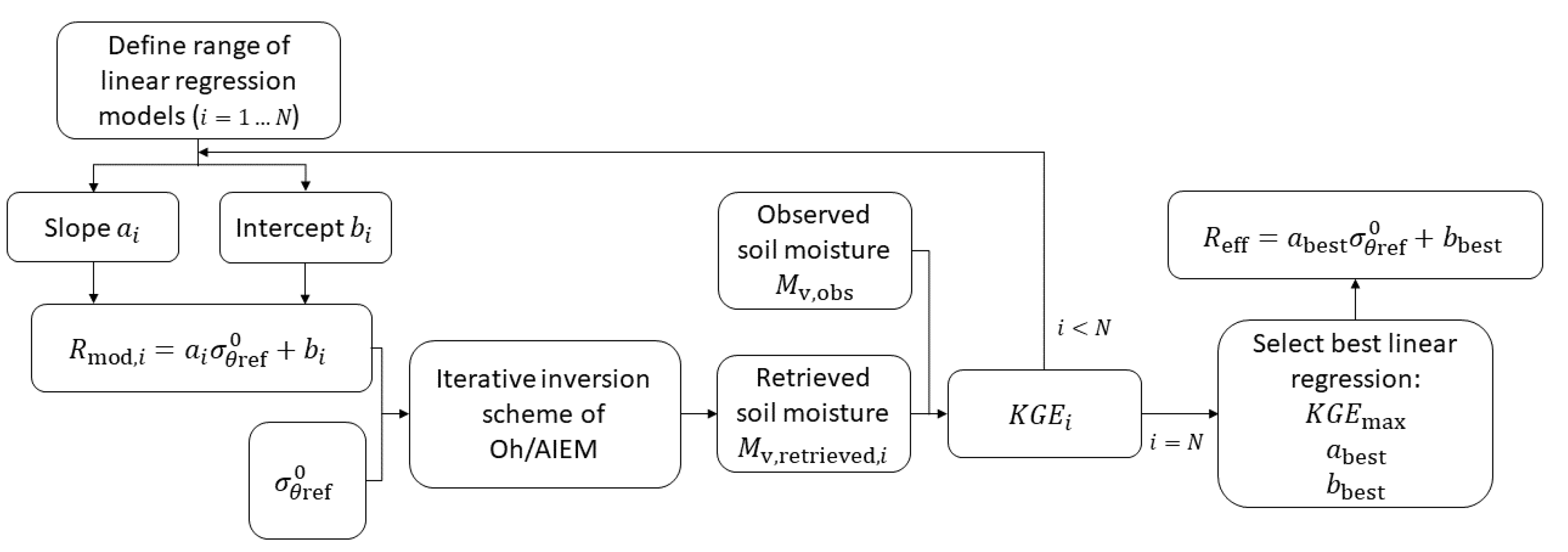
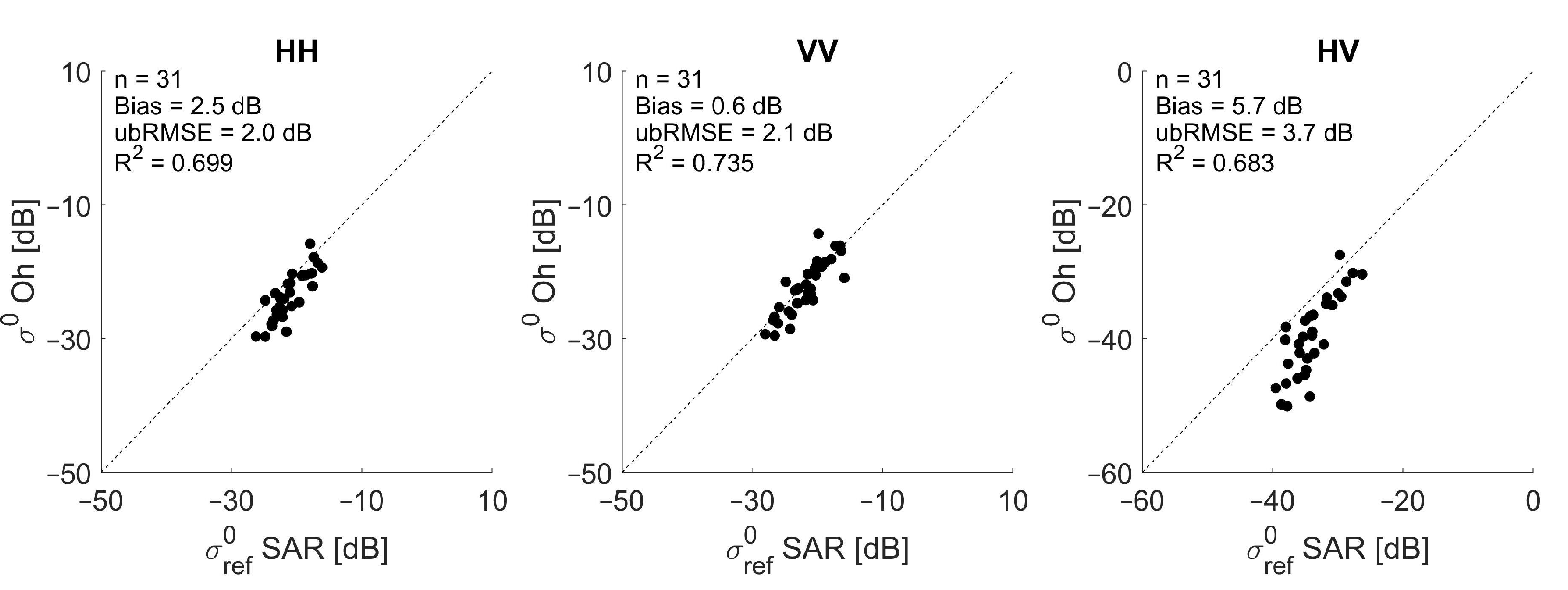
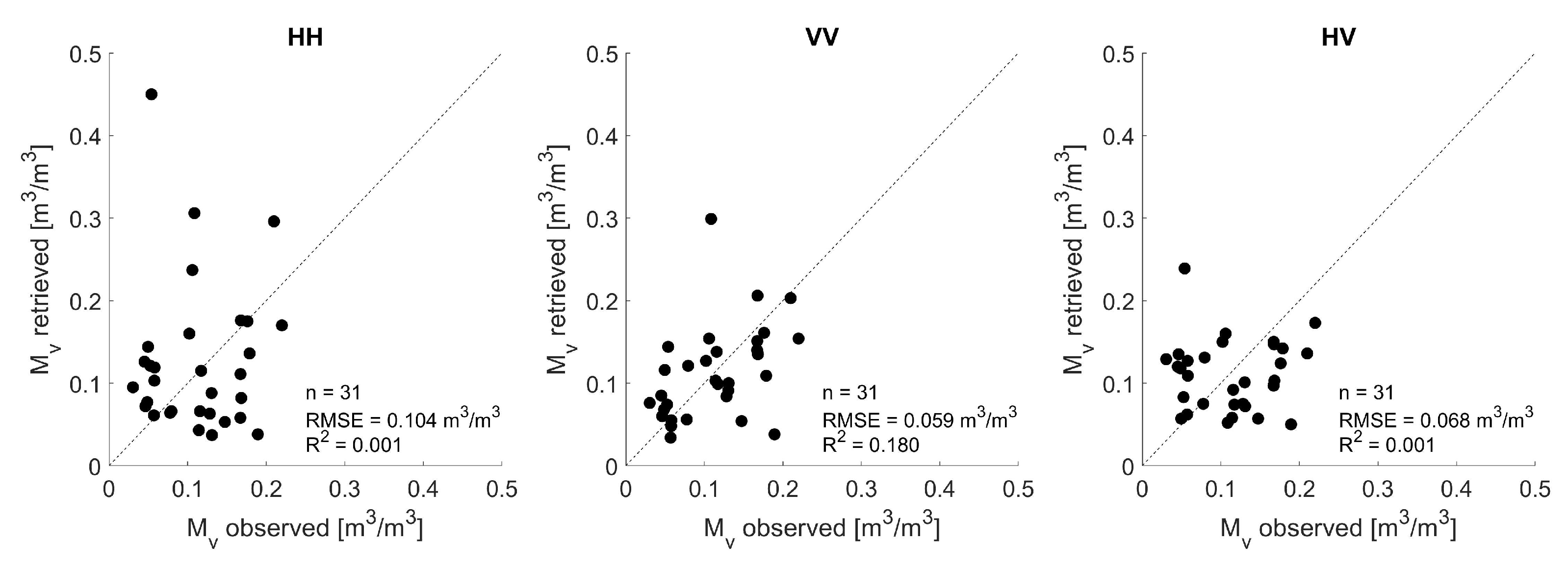

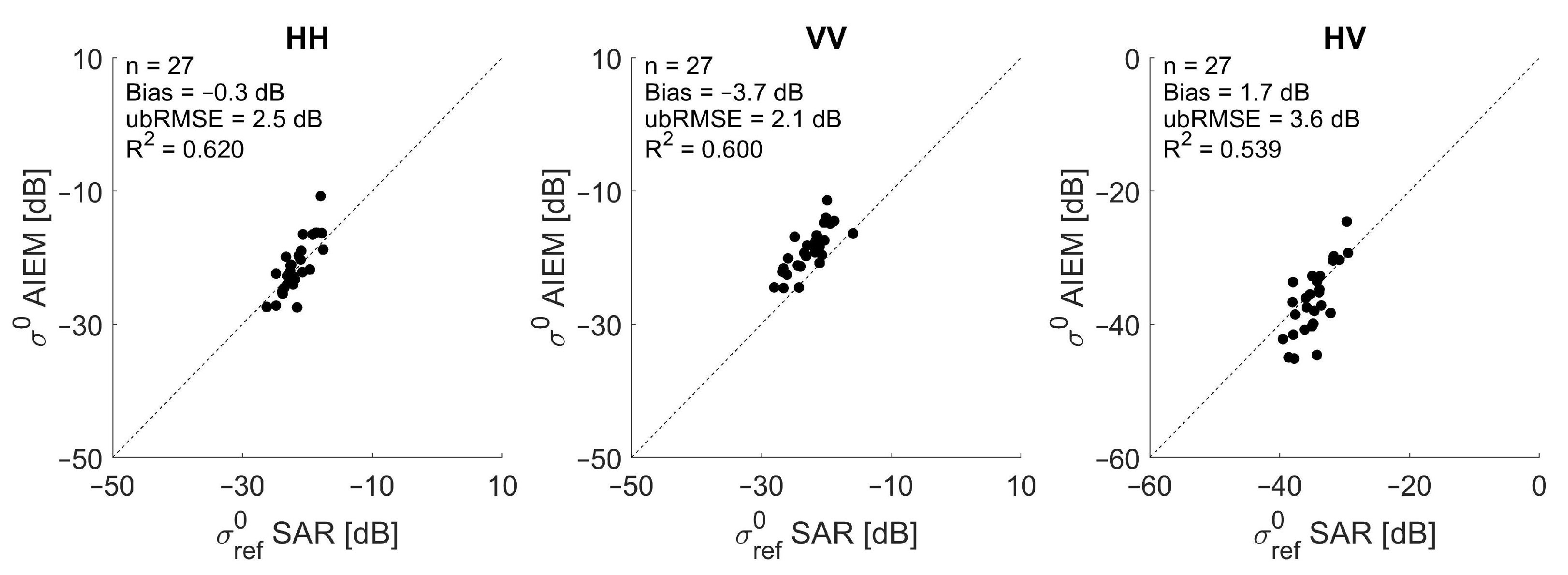
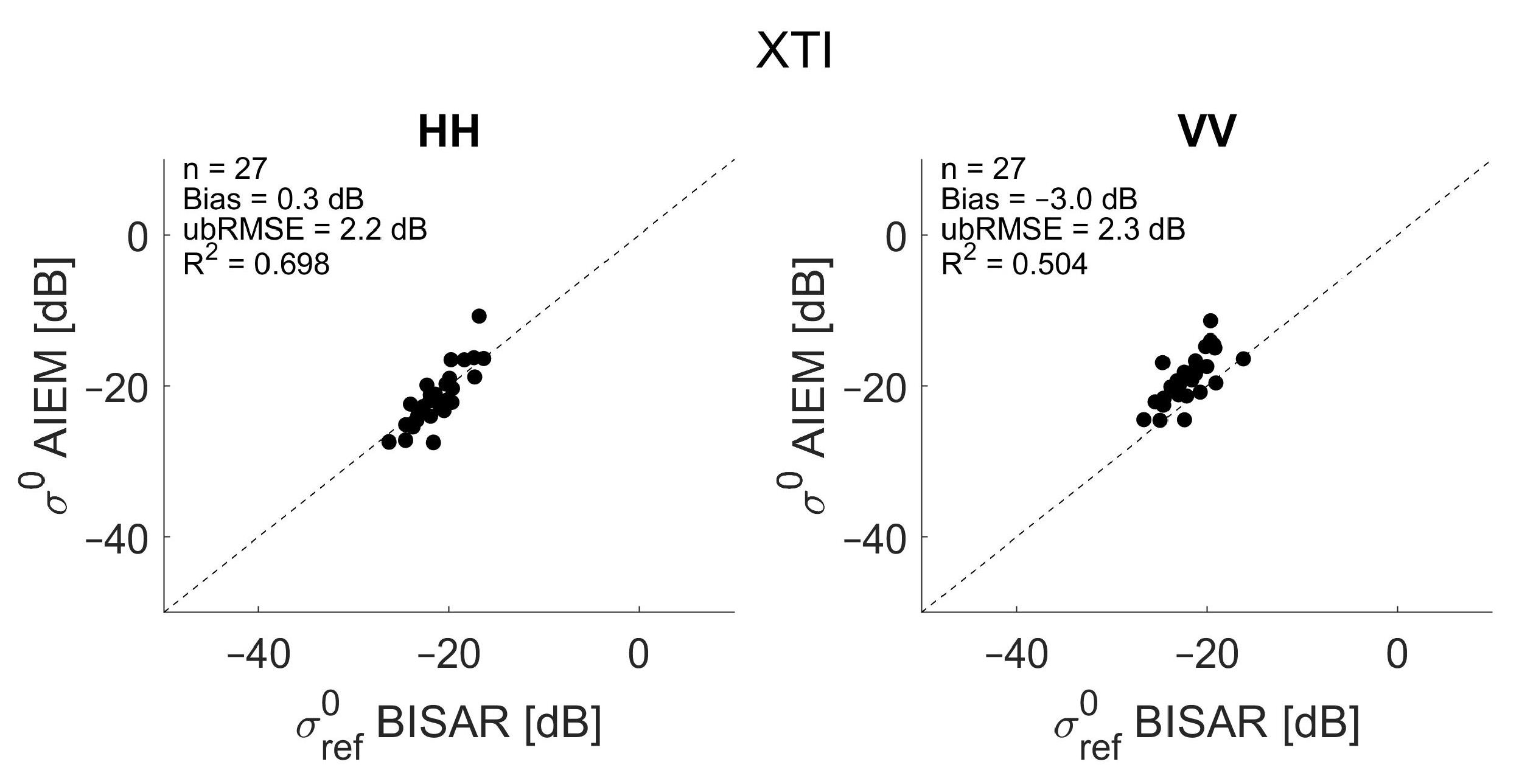
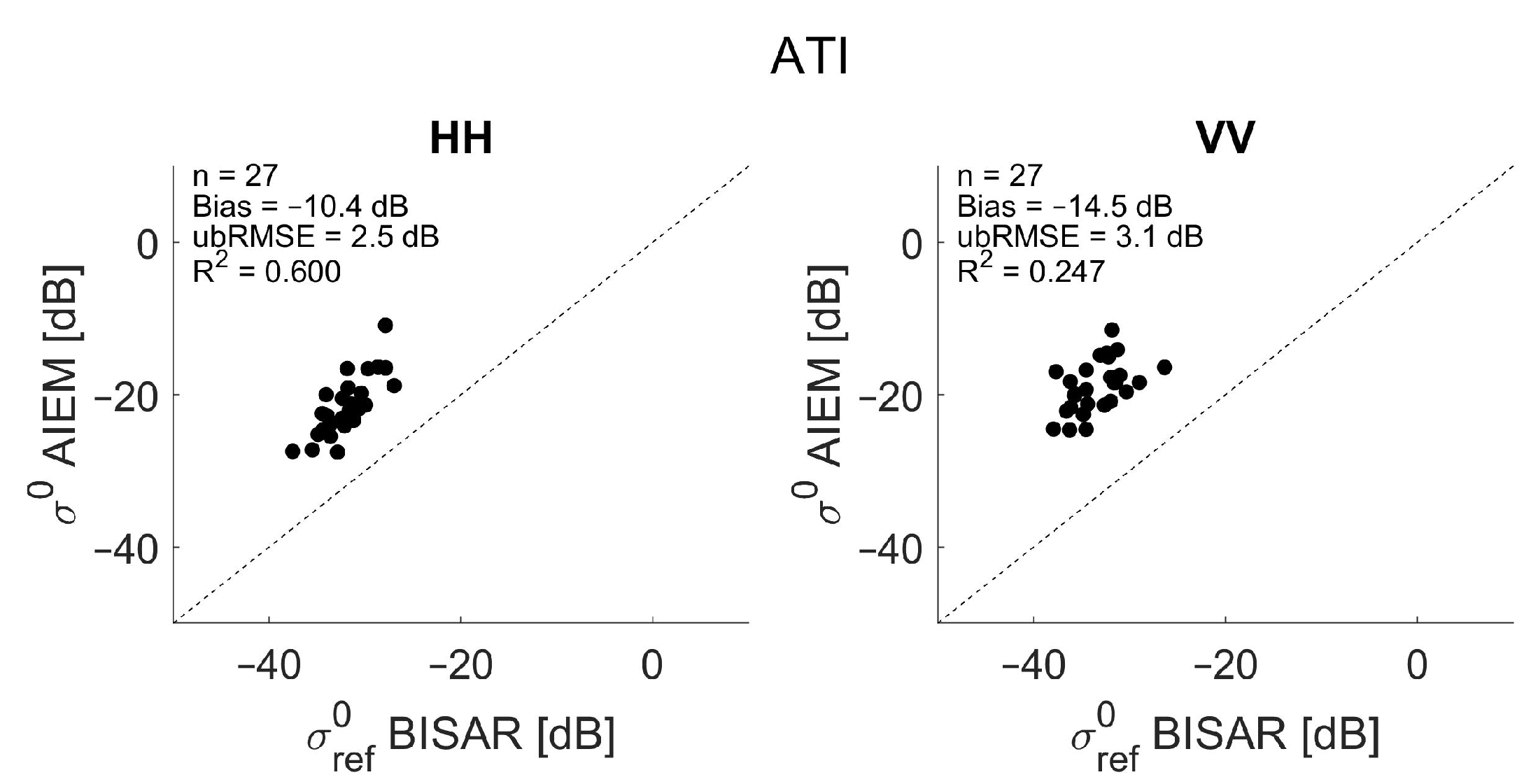
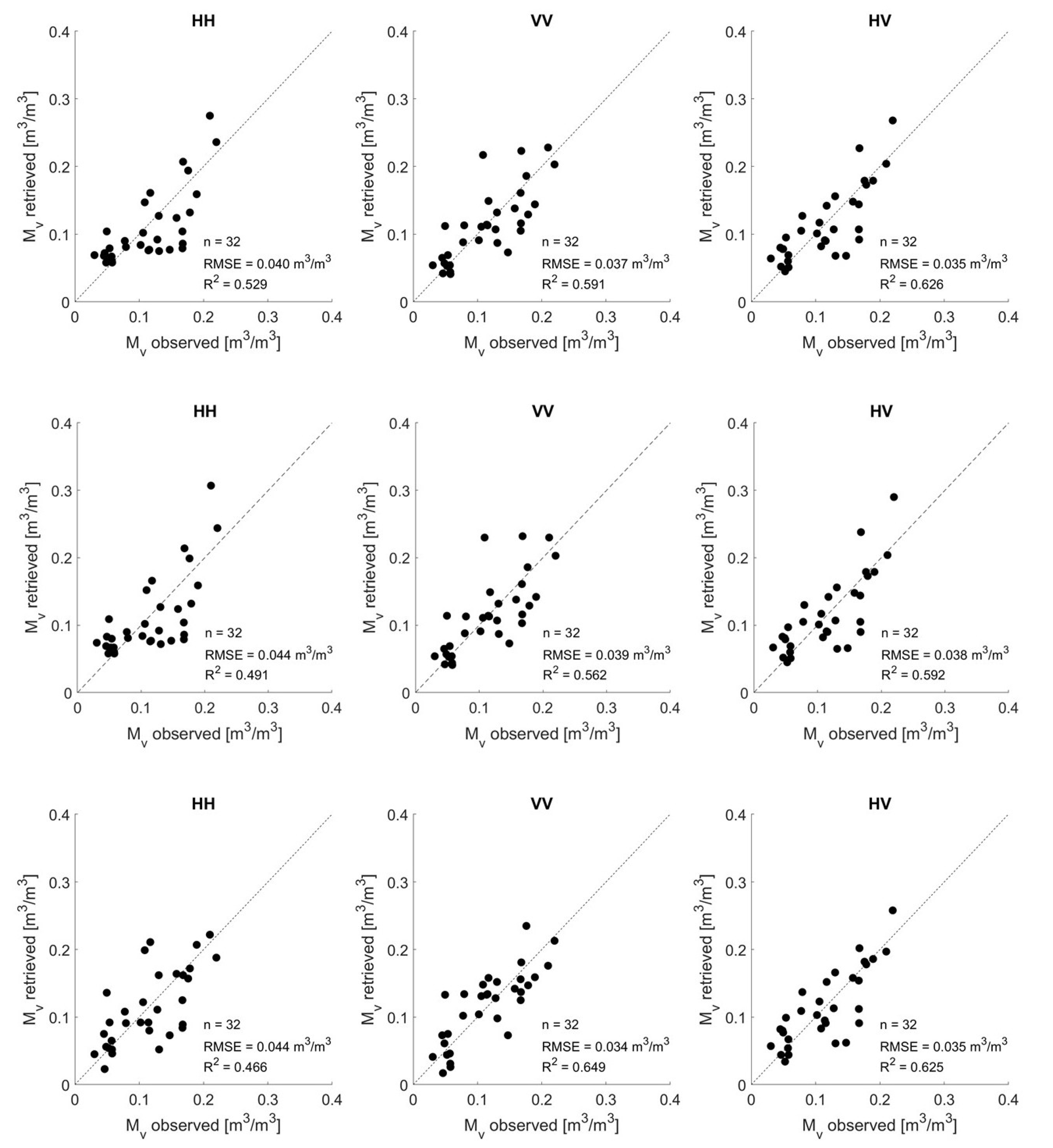


| Active-Passive SAR System | |
| Central Frequency | 1.375 GHz |
| Polarization | HH, VV, HV and VH |
| Signal Bandwidth | 50 MHz |
| Along-track baseline | ∼400 m |
| Across-track baseline | ∼25 m |
| Zenith incidence angle range | 20°–55° |
| Zenith scattering angle range | 20°–55° |
| Average azimuth scattering angle ATI | −171.6° |
| Average azimuth scattering angle XTI | −179.2° |
| L-Band Backscatter | KGEmax | ||
|---|---|---|---|
| HH | 0.083 | 2.88 | 0.723 |
| VV | 0.056 | 2.16 | 0.768 |
| HV | 0.025 | 1.87 | 0.791 |
| L-Band | KGEmax | ||
|---|---|---|---|
| HH | −1.7 | −5.7 | 0.566 |
| VV | −7 | −77.1 | 0.720 |
| HV | −8.5 | −203.3 | 0.682 |
| L-Band | KGEmax | |||
|---|---|---|---|---|
| XTI | HH | −1.3 | 0.9 | 0.667 |
| VV | −7.9 | −91 | 0.617 | |
| ATI | HH | −1.2 | 2.4 | 0.664 |
| VV | −8 | −90.9 | 0.575 |
Publisher’s Note: MDPI stays neutral with regard to jurisdictional claims in published maps and institutional affiliations. |
© 2022 by the authors. Licensee MDPI, Basel, Switzerland. This article is an open access article distributed under the terms and conditions of the Creative Commons Attribution (CC BY) license (https://creativecommons.org/licenses/by/4.0/).
Share and Cite
Tronquo, E.; Lievens, H.; Bouchat, J.; Defourny, P.; Baghdadi, N.; Verhoest, N.E.C. Soil Moisture Retrieval Using Multistatic L-Band SAR and Effective Roughness Modeling. Remote Sens. 2022, 14, 1650. https://doi.org/10.3390/rs14071650
Tronquo E, Lievens H, Bouchat J, Defourny P, Baghdadi N, Verhoest NEC. Soil Moisture Retrieval Using Multistatic L-Band SAR and Effective Roughness Modeling. Remote Sensing. 2022; 14(7):1650. https://doi.org/10.3390/rs14071650
Chicago/Turabian StyleTronquo, Emma, Hans Lievens, Jean Bouchat, Pierre Defourny, Nicolas Baghdadi, and Niko E. C. Verhoest. 2022. "Soil Moisture Retrieval Using Multistatic L-Band SAR and Effective Roughness Modeling" Remote Sensing 14, no. 7: 1650. https://doi.org/10.3390/rs14071650
APA StyleTronquo, E., Lievens, H., Bouchat, J., Defourny, P., Baghdadi, N., & Verhoest, N. E. C. (2022). Soil Moisture Retrieval Using Multistatic L-Band SAR and Effective Roughness Modeling. Remote Sensing, 14(7), 1650. https://doi.org/10.3390/rs14071650







